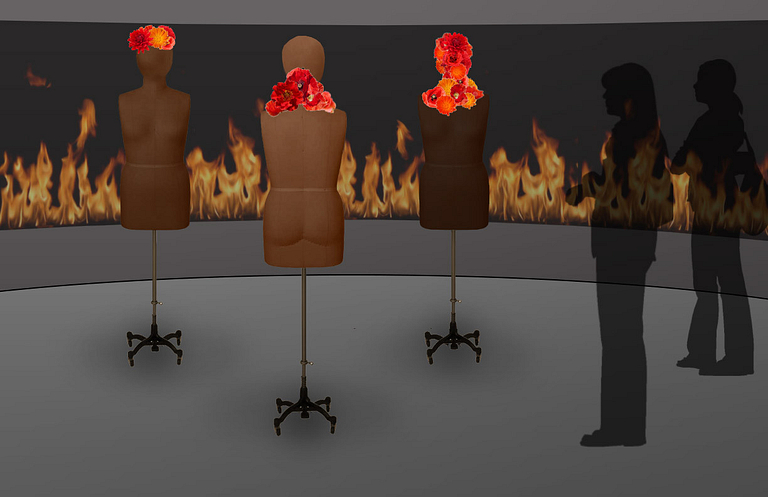
INDIANAPOLIS – A researcher at the Indiana University School of Nursing has created an educational art exhibit to refute myths, provide accurate and culturally appropriate information, and spur dialogue about menopausal hot flashes.
Developed by Distinguished Professor Janet S. Carpenter, associate dean for research, the “Hot flashes? Cool!” exhibit comprises seven pieces of two- and three-dimensional art, including several interactive pieces. Carpenter said her goal to counter myths and misinformation about hot flashes was strengthened when she chaired a panel of international menopause experts in 2015.

“The panel created an important paper commissioned by the North American Menopause Society, or NAMS, to provide recommendations for managing hot flashes without hormones,” she said. “‘Hot flashes? Cool!’ shares information found in the paper, as well as other information about menopausal hot flashes, with the public.”
Carpenter will take a full-size 3D exhibit piece to a May 11 women’s health luncheon in Boston to highlight the work of the Mary Horrigan Connors Center for Women’s Health and Gender Biology.
“The piece uses flowers and dress form mannequins to show where women in different cultures feel hot flashes on their body,” she said. “In Bangladesh, women feel them on the top of their head because their headscarves trap body heat. In the United States, women feel them on their face and chest. In Mexico, women feel them as sticky sweat on the back of their neck.
“The flowers symbolize the naturalness of hot flashes and also connote blooming and blossoming at menopause, which is a very positive message.”
Carpenter received a $200,000 grant from Pfizer Inc. to build the “Hot flashes? Cool!” exhibit and solicit public feedback. She also received a $50,000 IU New Frontiers Extraordinary Opportunities grant to video-document work on the exhibit, create an audio component and show portions of the exhibit at a national menopause conference.
Carpenter has worked with the IU Innovation and Commercialization Office to copyright descriptions of exhibit pieces and to trademark the exhibit’s logo. She lauded ICO for its work to transfer university knowledge to the public.
“Our goal is a more informed public to help women and their providers make better choices about menopausal health care,” she said. “Nearly three-fourths of women say they seek help from a health care provider for menopause, but most providers do not feel comfortable in managing menopausal symptoms. Most women report being confused about treatment options.”
Description of the following video:
[Carpenter speaks: “Hot flashes? Cool!” is an art exhibit that’s designed to educate the public about menopausal hot flashes.]
[Video: Janet Carpenter speaks on camera.]
[Carpenter speaks: We are using the creative arts to display scientific information from about 500 research studies that have been published. We know that women’s’ experiences at menopause are very individualized, very different from one another.]
[Video: Carpenter looks at drawing boards and mockups of art exhibits.]
[Carpenter speaks: There’s been research done that women in different cultures actually feel hot flashes differently.]
[Video: Carpenter appears on camera.]
[Carpenter speaks: We are using flowers on dress form mannequins to show those places on the body where women have hot flashes.]
[Video: Carpenter standing next to dress form mannequins, explaining floral symbolism.]
[Carpenter speaks: In the U.S., African-American and Euro-American women feel hot flashes on their chest and face. In Mexico, women feel hot flashes as a sticky sweat on the back of their neck. In Bangladesh, women feel hot flashes on the top of their head.]
[Video: Shots of the dress form mannequins with their flower representations.]
[Carpenter speaks: Part of the reason we are using flowers is to showcase hot flashes as a natural, normal phenomenon, and also to evoke blooming and blossoming at menopause.]
[Video: Carpenter talks on camera.]
[Carpenter speaks: There’s a lot of meaning and hidden symbolism hidden within the sculptural pieces. We are really trying to create a new image, collective image of menopausal health, and provide information to the public in a creative and engaging way.]
[Carpenter shows dress form mannequins, and then talks on camera.]
[Video: Closing outro appears on screen. An IU trident appears at the top of the screen. Underneath the trident are the words Indiana University, Fulfilling the Promise, iu.edu.]
About Indiana University Innovation and Commercialization Office
Indiana University ICO is tasked with the protection and commercialization of technology emanating from innovations by IU researchers. Since 1997, IU research has generated almost 3,000 inventions resulting in more than 4,500 global patent applications. These discoveries have generated more than $142 million in licensing and royalty income, including more than $115 million in funding for IU departments, labs and inventors.

